Reliance Small Cap Fund Invest Online

Small and midcap stocks have the potential to give higher returns than large cap stocks in a bull market. These stocks usually get beaten down more in market corrections, but good quality mid cap stocks rebound strongly when strength returns to equity markets. Over the past few months midcap stocks are rallying smartly, outperforming large cap stocks. In fact, over the last 3 years small and midcap funds as a category has clearly outperformed large cap funds by a big margin. Please see the chart below for the comparison of trailing annualized returns between midcap funds and large cap funds over the last 1, 2 and 3 year periods.
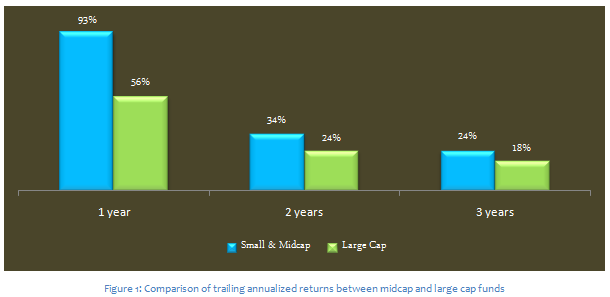
Within the small and midcap funds category, the Reliance Small Cap fund has given an exceptional performance, and is clearly the one of the best midcap funds over the last few years. Not only has it given the highest return in the last one year among all small and midcap funds, it has outperformed the category also in terms of two and three year trailing returns and generated superior alphas compared to most of the other small and midcap funds. Please see the chart below for the trailing annualized returns of Reliance small cap fund for 1, 2 and 3 years, in comparison with Midcap funds and the benchmark CNX Midcap index.
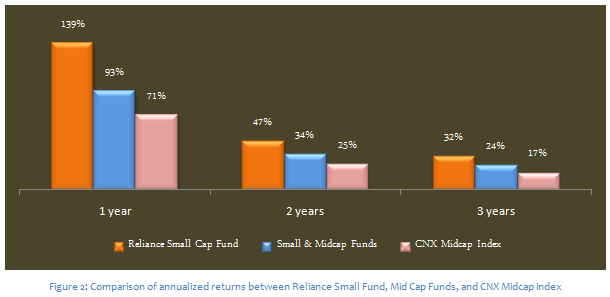
Fund Overview
This fund is suitable for investors with high risk tolerance, looking for high capital appreciation over the long term. However, investors in this fund should be comfortable with high volatilities of NAVs and returns. As such the fund is suitable for investors who have a sufficiently long time horizon. The fund was launched in September 2010. It has an AUM base of about Rs 566 crores. The expense ratio of this fund is 2.52%. The fund manager of this scheme is Sunil Singhania. The scheme is open both for growth and dividend plans. The current NAV (as on Aug 28 2014) is 20.43 for the growth plan and 18.68 for the dividend plan. The fund has been ranked 1 by CRISIL in its most recent mutual fund ranking. Morningstar has a 4 star rating for this fund.
Portfolio Construction
The portfolio has a bias for small and midcap stocks with high growth potential. In terms of sector allocations, the portfolio is heavily weighted towards cyclical sectors like Chemicals, BFSI, Cement & Construction, Engineering and Automobiles. In terms of company concentration, the portfolio is very well diversified with its top 5 holdings, accounting for only 19% of the total portfolio value. Even the top 10 stock holdings account for less than 32% of the portfolio value. The fund manager allocates 18% of his portfolio in cash and cash equivalents, to meet liquidity needs and leverage investment opportunities.
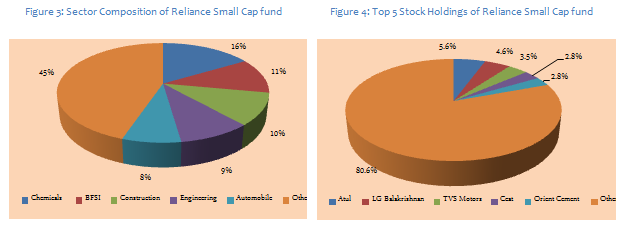
Comparison with Peer Set
A comparison of annualized returns of Reliance Small Cap fund versus its peer set over various time periods shows why this fund is considered a top pick in its category. See chart below for comparison of annualized returns over one, three and five year periods. NAVs as on August 28 2014.
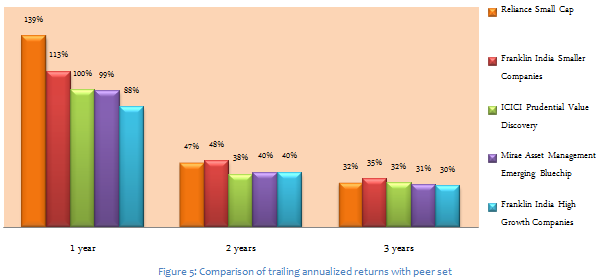
Risk & Return
From a risk perspective, the volatility of the fund is slightly on the higher side. The annualized standard deviation of monthly returns of Reliance Small Cap Fund is 23.76%, which is on the higher side even relative to the riskier small and mid cap category. While the high volatility is definitely a watch out for the fund from a risk perspective, the risk adjusted return of the fund is very attractive. On a risk adjusted basis, as measured by Sharpe Ratio, the fund has outperformed the diversified category. Sharpe ratio is defined as the ratio of excess return (i.e. difference of return of the fund and risk free return from Government securities) and annualized standard deviation of returns. Higher the Sharpe ratio better is the risk adjusted performance of the fund. See charts below for comparison of volatilities and Sharpe ratios between Reliance Small Cap fund and small and midcap funds category.
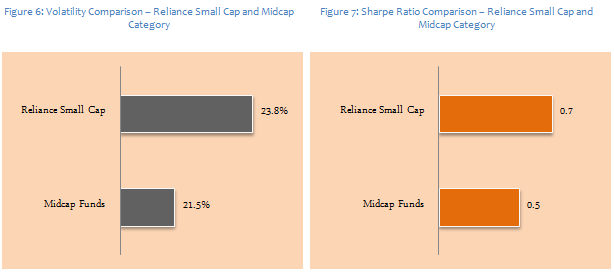
Rs 1 lac lump sum investment in the Reliance Small Cap fund NFO (growth option) in September 2010 would have doubled by August 28 2014. The chart below shows the growth of Rs 1 lac investment in the Reliance Small Cap fund (growth option).
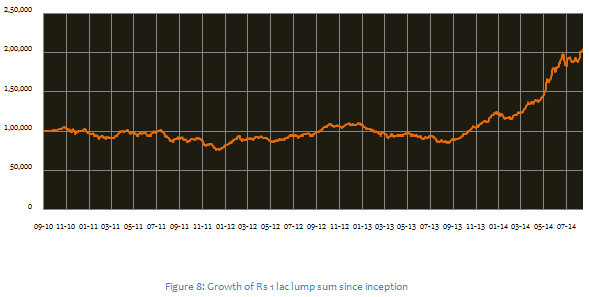
A SIP investment in the Reliance Small Cap fund would have performed even better. The chart below shows the returns since inception of Rs 3000 invested monthly through SIP route in the Reliance Small Cap fund (growth option). The SIP date has been assumed to be first working day of the month. The chart below shows the SIP returns of the fund. NAVs as on August 28 2014.
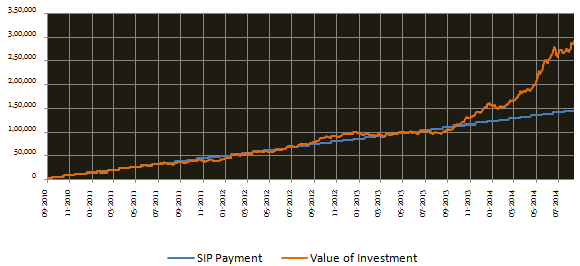
A Rs 3000 monthly SIP in the Reliance Small Cap fund (growth option) since inception would have grown to almost Rs 3 lacs as on August 28 2014, while the investor would have invested a little over Rs 1.4 lacs. This implies that the fund gave a SIP return of over 37% since inception. Very few mutual fund investments give that kind of returns over a 3 – 4 year period.
Conclusion
The Reliance Small Cap fund has delivered strong performance since its inception. With the improving sentiments in the Indian equity markets the fund seems poised to deliver even stronger performance in the future. Investors with high risk tolerance can consider investing in the fund through the systematic investment plan (SIP) route for their long term financial planning objectives. Even though small and midcap funds like Reliance Small Cap fund can give higher returns than large cap or diversified equity funds, investors should also remember that the risk associated with small and midcap funds are higher. Investors should consult with Prajna Capital if this fund is suitable for their investment portfolio, in line with their risk profiles.
Top 10 Tax Saving Mutual Funds to invest in India for 2016
Best 10 ELSS Mutual Funds in india for 2016
1. BNP Paribas Long Term Equity Fund
2. Axis Tax Saver Fund
3. Franklin India TaxShield
4. ICICI Prudential Long Term Equity Fund
5. IDFC Tax Advantage (ELSS) Fund
6. Birla Sun Life Tax Relief 96
7. DSP BlackRock Tax Saver Fund
8. Reliance Tax Saver (ELSS) Fund
9. Religare Tax Plan
10. Birla Sun Life Tax Plan
Invest in Best Performing 2016 Tax Saver Mutual Funds Online
For further information contact Prajna Capital on 94 8300 8300 by leaving a missed call
---------------------------------------------
Leave your comment with mail ID and we will answer them
OR
You can write to us at
PrajnaCapital [at] Gmail [dot] Com
OR
Leave a missed Call on 94 8300 8300
-----------------------------------------------